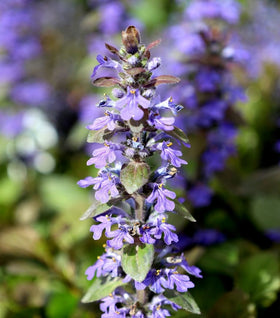Ajuga Plants for Sale Online
When you’re looking for something attractive to fill in a large area quickly, then you can’t go wrong with ajuga. Ajuga plants are known for their wide array of foliage colors. The most commonly seen ajuga has rich deep burgundy leaves. Others produce cream-colored leaves with pink edges. Ajuga or carpet weed makes a beautiful groundcover plant and can be used in many garden areas. In the summer, ajuga reptans is covered in spikes of bright blue or purple flowers. Ajuga plants are deer resistant, so there's no need to worry about deer destroying your groundcover.
How Does Ajuga Spread
The common name of ajuga is carpetweed or bugleweed, and you could surmise that ajuga is a vigorous grower. Ajuga produces rosettes of leaves that root where they touch the ground. Ajuga plants spread steadily by sending out plenty of rosettes attached to stolons. At each rosette on this stolon, the plant also develops roots and forms another central crown of leaves—this allows them to form dense colonies of plantlets, creating a thick mat of colorful foliage.
Growing Ajuga as a Groundcover
Ajuga is a low maintenance ground cover plant that is considered to be fast-growing. Because of its ground-hugging nature, it rarely needs to be cut back in the spring, and the flowers don't need any deadheading due to their short size. In mild climates, ajuga plants can be semi-evergreen, So if you live in an area with mild winters, the foliage from last fall may still look good in the spring.
Where to Use Ajuga in the Garden
Choosing the best Ajuga types involves just a little forethought. Getting the most from your investment depends on the foliage color. In general, ajugas can handle anything from full sun to complete shade.
In the shade, the dark, shiny burgundy foliage of Black Scallop or Burgundy Glow will be a tad duller and may take on some green coloring in full shade, but will grow just fine. Overall you will achieve the best leaf color in at least a half-day of sun.
Ajuga performs best in well-drained, moist, to average garden soil. Ajuga can handle drought and dry soils well but occasionally could use supplemental watering during periods of drought. The biggest concern with ajuga is to make sure the plant doesn't stay too wet because crown rot can be a common problem. To prevent this, make sure you don't plant your groundcover ajuga in areas of the landscape that always remain wet.
Using Ajuga Plants in Containers
Some miniature varieties, such as Ajuga Chocolate Chip, make great additions to trough gardens and containers. They will often spill over the edges of the pot, making them perfect for use as a spiller in the thriller, filler, spiller method of planting containers. They can also help reduce soil moisture loss as they can cover the planting soil's entire surface.
Proper Spacing for Ajuga Plants
Plant Ajuga bugleweed in an area where air circulation is good, spacing the plants about 1 foot apart. Smaller Varieties like Ajuga Chocolate Chip should be spaced closer to about 6 to 8 inches apart as they typically will not send out long runners.
How to Propagate Ajuga Plants
Ajuga is one of the easiest plants to propagate. It spreads by runners that form clumps surrounding the parent plant. When these clumps begin to get too crowded, you can dig them up and transplant them. This is best done in spring or fall when there is no chance of frost.
Dig up the entire mother plant and surrounding clumps or selectively remove small clusters from within the mother plant, separate them by hand or with a sharp knife, and plant the individual plants in new locations. Keep the divided plants moist for a few weeks until they develop a healthy root system.





